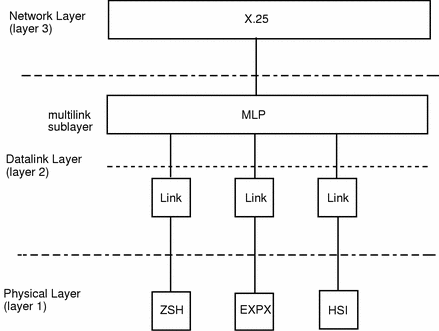X.25 Datalink Layer
The datalink layer's role is to specify the link access procedure for the exchange of data across the physical link. This layer must ensure that all data transmitted at one end of a link reaches the other end intact.
This means that as well as mechanisms for transmitting data, the datalink layer must provide ways of telling whether data has reached its destination correctly, and retransmitting if it has not.
The X.25 Recommendation defines two possible datalink layers: LAP and LAPB. In practice, LAP is rarely used. A Multilink Procedure (MLP) allows for multilink operations. It is used along with LAPB.
Single Link Operations
Figure 2-4 shows the standard frame structure for a bit-oriented datalink layer frame. The shaded parts are supplied by the datalink layer. The Data field contains the data supplied by higher layer protocols. Sizes are given in octets
Figure 2-4 Datalink Layer Frame Structure

Datalink layer frames are structured as follows:
- Flag
-
Frames are delimited at each end by a flag, with the value 01111110. This is necessary because X.25 is synchronous - in other words, data is transmitted as a continuous stream.
- Address
-
This is one octet. The value varies, depending on the direction of data flow, and on whether this is a single or multilink operation.
- Control
-
The control octet define the type of frame this is: an I(nformation)-frame containing data, a S(upervisory)-frame, which is a response frame, or an U(nnumbered)-frame, which performs control functions.
- Data
-
The data field contains X.25 protocol information, as well as user data from higher layer protocols. A frame need not contain data.
- Checksum
-
The two-octet checksum follows the data, and is derived from the contents of the data packet. It is usually generated automatically by the hardware.
Multilink Operations
Figure 2-5 Multilink Operation

The Multilink Protocol (MLP) lets you use more than one physical connection to make a single logical connection. This increases the amount of bandwidth available between the DTE and DCE improving response times and increasing traffic levels. An MLP connection does not provide a multiple channel end to end connection to remote DTEs. Not all of the DTEs attached to the PSDN need to use MLP and not all DTEs need to use the same number of physical connections.
The internal structure of X.25 when using MLP is shown below:
Figure 2-6 Internal Structure of X.25 When Using MLP

MLP frames have two additional octets placed between the control octet and the data. These octets enable each frame to have a sequence number so that it can be reassembled in the correct order at the receiving end. The two extra octets are not present in the standard datalink frame shown in Figure 2-4.
- © 2010, Oracle Corporation and/or its affiliates
